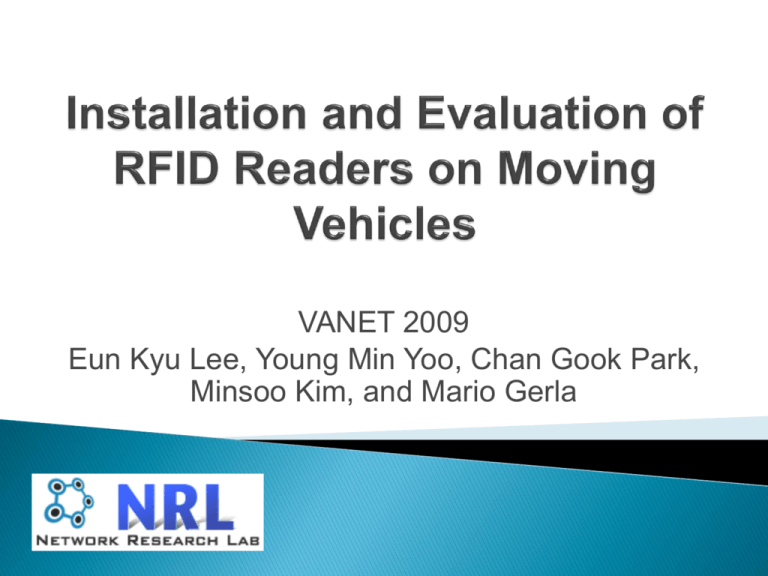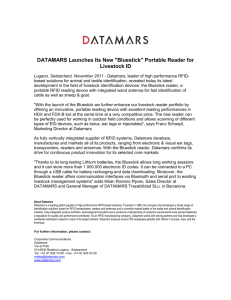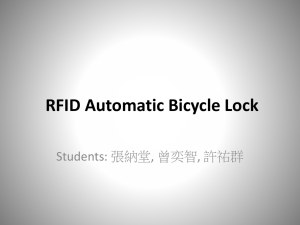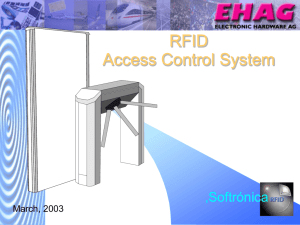PPT file of slides
advertisement

VANET 2009 Eun Kyu Lee, Young Min Yoo, Chan Gook Park, Minsoo Kim, and Mario Gerla RFID applications ◦ RFID-enabled vehicular applications RFID system ◦ RFID read performance 2 Installation of RFID system on vehicle Road test Conclusion Supply Chain & Warehouse ePassport www.infoworld.com 3 Human implant www.wikipedia.org Automatic toll collection www.ezpass.com Smart payment 4 www.ti.com 5 RFID system review RFID communication What is RFID? ◦ Identify physical objects Antenna through a radio interface ◦ Identification? Assign ID to each object Bar code, license plate, student ID How does RFID work? ◦ RFID tag + RFID reader + antenna ◦ Backscattering coupling (UHF) 02.3DFEX4.78AF51 EasyToll card #816 6 Chip Tag type Passive tag Power No power source Internal battery Pros Small & cheap (~10cents) Long radio range (~150m) & high performance Cons Short radio range (~10m) Expensive & limited lifetime www.hitachi.com & www.vicariousconversations.com Radio frequency range Frequency HF UHF Microwave 13.56MHz 433.92MHz 860-960MHz 2.45GHz Range < 60Cm 50~100Cm < 3.5m, <10m 1m Tag Passive Active Passive/Active Passive/Active Property - Cheap reader - Short range Contact time Tag size Application - Real-time tracking - Cheapest - Multiple-tag contact Slow --------------------------------- Robustness (Sensitivity) 7 Active tag - Library books - Access Control - Sensitive to noise Fast Robust --------------------------------- Sensitive Big --------------------------------- Small - Container - Real-time location tracking - Automatic tolling - Supply chain tracking - Asset tracking - Forgery avoidance Framed slotted Aloha (FSA) A response from one RFID tag Slot CW 8 Query Cycle Power down CW Query Cycle .. .. . Power down .. .. .. 9 RFID-enabled Vehicular Applications On-board RFID reader system Methodology of data producer/consumer ◦ RFID tag Stores data in memory, which is provided to RFID readers A data producer ◦ RFID reader Obtains RFID data from tags and utilizes it for further programs A data consumer 10 Each vehicle is a data producer !! Tag on vehicle (data producer) ◦ ◦ ◦ ◦ ◦ Readers are on the roadside Automatic toll collection Intelligent traffic signal system Electronic license plate Priority lane management Enforce Lane reservation and enforcement www.ti.com cs.rutgers.edu Reservation/ Enforcement System Enforce Reserve Reserve RFID Reader/ Camera Lane Entrance Assistance System Low-Priority Lanes High-Priority Lane 11 Reader on vehicle (data consumer) ◦ Tags on the roadside units (road surface, sign post, direction sign) ◦ RFID positioning and Road beacon system (RBS) ◦ Lane-level GPS (Donath’06) RFID tags along each lane contains useful data (e.g., position) Intersection collision avoidance, Enhancement of driver’s situation awareness, Lane by lane incident management RFID reader RFID tag 12 Tag/reader on vehicle (data prosumer) ◦ Intelligent priority lane management ◦ Peer localization RFID tag RFID reader 13 Challenges ◦ High vehicle speed Faster than 100Km/h on a freeway ◦ Short communication distance 0.3m Much less chance of RFID communication ◦ Random mobility of reader Reader position affects performance significantly than tag placement Random fading effects RFID tag RFID reader 14 3m~4m Motivation ◦ Initial deployment of RFID reader/tag is important for better performance ◦ Necessary to measure performance in a real test road In this work, we ◦ Install RFID reader on a vehicle and tags on a road surface ◦ Evaluate RFID read performance in a laboratory environment ◦ Propose antenna diversity and tag multiplicity for improvement ◦ Conduct a road test to study feasibility of the system 15 Specification of the RFID system RFID performance ◦ RFID read area ◦ Read latency ◦ RFID read rate 16 Server RFID reader Frequency RF power Read distance Modulation Radio access 910~914MHz 4w EIRP ~5m ASK FHSS RFID reader antenna Angle Gain Size 60°(3dB) 6 dBi 215x420x55 RFID tag Data Data rate Max pause time 64bit 256kbps 62.5ms RFID Communication RFID Reader Data Energy RFID Reader Antenna 17 Antenna EEPROM RFID Tag RFID read area RFID read area ◦ Size and moving speed RFID Reader Antenna h cm RFID Reader Antenna 68° Read area Front view X1 cm Side view h cm θ° 68° Read area X 2 cm For instance, if h=37.5cm and θ=45°, then X1=58.58cm and X2=185.63cm Measured X2≒100cm (1m) 18 Moving speed of RFID area Speed [km/h] Computed [ms] Measured [ms] 10 665 360 20 332 180 30 222 120 40 166 90 50 133 72 60 111 60 70 95 51 80 83 45 90 74 40 100 67 36 RFID communication should occur in 1m read area within 36m Read latency ◦ Time period when one RFID communication occurs ◦ Measured 38.39ms on average Mostly due to the maximum pause time of the tag: 62.5ms ◦ However, RFID read area moves at 36ms > 38.39ms Even 60ms at 60km/h < 62.5ms High possibility of RFID communication failure RFID read rate # of tags successfully read = ----------------------total # of tags deployed 19 <- 36ms 38.39ms Experiment setup RFID reader antenna ◦ Height ◦ Pitch angle ◦ Antenna diversity RFID tag ◦ Yaw angle ◦ Pitch angle ◦ Tag multiplicity 20 Result Target performance ◦ 0.5m of read area and 18m of read latency Height of RFID reader antenna h=30cm ◦ Similar performance in h=20~40cm ◦ Height of the test vehicle is 30cm Installation 18ms of read latency ◦ RFID reader antenna & RFID tag RFID reader antenna RFID tag 21 30°of tag yaw angle and 30°of antenna pitch angle 0.5m Pitch angle ◦ Varying pitch angle of the antennas ◦ Measure the read area given 18ms of read latency ◦ 30° of pitch angle Pitch angle of antenna 70° 60 50 ° ° RFID tags are attached on the floor with 0° 0º 10º 20º 30º 40º 50º 60º 70º ° 40 ° 30 20 ° 10 ° 0° RFID Reader Antenna 21cm 21cm 30cm 70° of pitch angle 60° 50° 40° 30° 20° 0° Floor 50.86 54.62 72.38 73.89 74.40 65.58 66.77 68.95 70cm 10° 22 Length of read area [cm] Side view Antenna diversity ◦ Install one and dual antenna(s) ◦ Measure the read area given 18ms of read latency 78 cm 80 cm RFID Tag 43 cm RFID Reader Antenna RFID Reader Antenna 1 65 cm RFID Reader Antenna 2 1.5m 1 Antenna 3m 0.86m 2 Antennas 23 RFID Tag 1.3m 2m Yaw angle and pitch angle ◦ Measure the read latency given 0.5m of the read area 30° of reader antenna ◦ Both are set 0° RFID Reader Antenna Yaw angle Yaw angle (front view) er A d a Re nna e t n 30° pitch 0 deg 60 pitch 10 deg 50 pitch 20 deg 40 30 20 10 0 -20 -15 -10 0 10 20 30 40 50 60 70 80 30cm Distance from the center of reader antenna to a tag [cm] Pitch angle Floor Pitch angle (side view) 24 Average read latency [ms] 70 RFID Tag Yaw angle 0° 30° 60° 90° 120° 150° 180° Read latency 44.3 44.2 x x x 45.1 46.9 Tag multiplicity ◦ To mitigate effect of the random pause time ◦ Measure the read latency given 0.5m of the read area ◦ Cluster model 3 having 3 or 4 member tags Cluster 2 Cluster 3 Cluster 4 40 Average read latency [ms] Cluster 1 Cluster 1 Cluster 3 35 Cluster 2 Cluster 4 30 25 20 15 10 1 2 3 4 Number of RFID member tags in a cluster 25 5 RFID communication successfully occurs within 0.8m of RFID read area and 18ms of read latency Antenna diversity and tag multiplicity ◦ Showed improved performance Estimation of the maximum vehicle speed ◦ At which RFID communication can occur ◦ 161.7km/h ◦ Equivalent to previous researches 26 27 Test road configuration Effect of antenna diversity Effect of tag multiplicity Server RFID Reader RFID reader antenna Number RFID Reader Antenna Height RFID Tag Pitch Test scenarios with variables 1 or 2 Yaw 0° 30cm Pitch 0° 30° Member tags 1, 3, or 4 Test1 Test2 Test3 Test4 Test5 Test6 # of antenna 1 2 2 2 2 2 # of member tags 1 1 3 4 3 4 2m 2m 2m 2m 5m 5m ~100 ~80 ~80 ~80 ~80 ~100 RFID tag interval 28 RFID tag Maximum speed [km/h] Deployment parameters Effect of antenna diversity ◦ Proof of concept in terms of width ◦ Reduced length does not affect performance much Average duplication read [number] 10 1 Antenna 1.5m Single RFID reader antenna 8 Dual RFID reader antenna 6 4 2 0 10 20 30 3m 50 60 70 80 90 100 Vehicle speed [km/h] 2m 0.86m 40 RFID Tag 1.3m 2 Antennas Average read rate [%] Average duplication read 100 Single RFID reader antenna 80 Dual RFID reader antenna 60 40 20 0 10 20 30 40 50 60 Vehicle speed [km/h] 29 Average read rate 70 80 90 100 Effect of tag multiplicity ◦ Tag cluster outperforms single tag (Test 2, 3, and 4) ◦ Tag interval influences performance (Test 3 and 5) In particular, at high speed ◦ Duplication read dramatically decreases at high speed 100 1 Tag, 2m Interval (Test 2) 3 Tags, 2m Interval (Test 3) 4 Tags, 2m Interval (Test 4) 3 Tags, 5m Interval (Test 5) 4 Tags, 5m Interval (Test 6) 25 20 90 80 Average Read Rate [%] Average Duplication Read [number] 30 15 10 60 50 40 1 Tag, 2m Interval (Test 2) 3 Tags, 2m Interval (Test 3) 4 Tags, 2m Interval (Test 4) 3 Tags, 5m Interval (Test 5) 4 Tags, 5m Interval (Test 6) 30 20 5 10 0 0 10 20 30 40 50 60 70 Vehicle Speed [km/h] Average duplication read 30 70 80 90 100 10 20 30 40 50 60 70 Vehicle Speed [km/h] Average read rate 80 90 100 Summary ◦ RFID-enabled vehicular applications ◦ On-board RFID reader system ◦ Experiment In a laboratory RFID reader antenna and RFID tag On a test road Contribution ◦ A different approach to RFID-enabled vehicular system ◦ Address antenna diversity and tag multiplicity The newest topics for performance improvement ◦ Experiment data from a real test bed 31 VANET 2009







